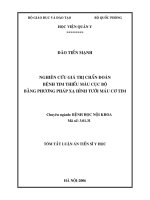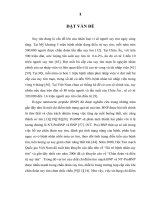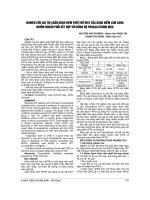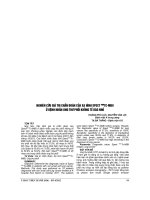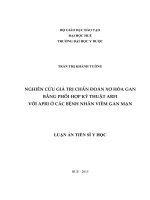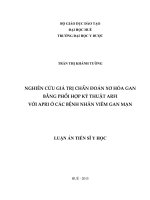nghiên cứu giá trị chẩn đoán xơ hóa gan bằng phối hợp kỹ thuật arfi với apri ở các bệnh nhân viêm gan mạn
Bạn đang xem bản rút gọn của tài liệu. Xem và tải ngay bản đầy đủ của tài liệu tại đây (144.94 KB, 4 trang )
<span class='text_page_counter'>(1)</span><div class='page_container' data-page=1>
<b>NHỮNG ĐÓNG GÓP MỚI CỦA LUẬN ÁN </b>
<b>Tên đề tài luận án: Nghiên cứu giá trị chẩn đốn xơ hóa gan bằng phối hợp kỹ thuật </b>
<i><b>ARFI với APRI ở các bệnh nhân viêm gan mạn </b></i>
<b>Chuyên ngành: NỘI TIÊU HOÁ </b>
<b>Mã số: 62.72.01.43 </b>
<b>Họ và tên nghiên cứu sinh: TRẦN THỊ KHÁNH TƯỜNG </b>
<b>Họ và tên người hướng dẫn: </b>
GS.TS. HOÀNG TRỌNG THẢNG
<b>Cơ sở đào tạo: Đại Học Huế - Trường Đại học Y Dược Huế </b>
<b>Tóm tắt những đóng góp mới của luận án: </b>
Xơ hố gan là hậu quả của tổn thương mạn tính ở gan. Xơ hoá gan sẽ diễn tiến đến
xơ gan và ung thư gan. Đánh giá mức độ xơ hoá gan rất quan trọng để quyết định điều trị,
theo dõi và tiên lượng viêm gan mạn, góp phần quan trọng để giảm tần suất tiến triển xơ
gan và ung thư gan.
Đây là luận án đầu tiên trên thế giới cũng như ở Việt Nam về việc kết hợp kỹ
thuật ARFI với APRI, 2 phương pháp không xâm nhập, trong chẩn đoán các mức độ
xơ hoá gan ở các bệnh nhân viêm gan mạn. Luận án giúp có một cái nhìn tồn diện về
vai trị của kỹ thuật ARFI, APRI và sự phối hợp của 2 phương pháp này trong đánh giá
xơ hoá gan ở bệnh nhân viêm gan mạn.
Chúng tôi xác định được vận tốc sóng biến dạng có tương quan thuận với giai đoạn
xơ hóa gan theo Metavir và APRI có mối tương quan thuận với vận tốc sóng biến dạng
và với giai đoạn xơ hóa gan theo Metavir.
Chúng tôi cung cấp độ nhạy, độ đặc hiệu, các giá trị dự đốn và độ chính xác của
APRI, kỹ thuật ARFI và sự phối hợp 2 phương pháp này trong chẩn đốn xơ hóa gan:
</div>
<span class='text_page_counter'>(2)</span><div class='page_container' data-page=2>
với giá trị ngưỡng 1,163, APRI có độ nhạy 40%, độ đặc hiệu 96,6%, PPV 80% và
NPV 82,7%. APRI có độ đặc hiệu cao trong cả 2 mức độ xơ hóa, đặc biệt PPV và
NPV cao đối với xơ hóa nặng, do đó giúp loại trừ và xác định xơ hóa nặng.
<b>- Kỹ thuật ARFI có độ chính xác tốt đối với xơ hóa đáng kể với AUROC là </b>
0,86 và rất tốt đối với xơ hóa nặng với AUROC là 0,93. Đối với xơ hóa đáng kể:
giá trị ngưỡng của SWV là 1,29 m/s, có độ nhạy 79,3%, độ đặc hiệu 89,4%, PPV
85,7% và NPV 84,3%; đối với xơ hóa nặng: giá trị ngưỡng của SWV là 1,36 m/s
có độ nhạy 96,67 %, độ đặc hiệu 86,52%, PPV 70,7% và NPV 98,7%. Kỹ thuật
này có độ đặc hiệu và NPV cao trong cả 2 mức độ xơ hóa gan, do đó giúp xác định
và loại trừ tốt xơ hóa đáng kể và rất tốt đối với xơ hóa nặng. Giá trị ngưỡng của
SWV là: 1,18m/s cho ≥ F1, 1,29 m/s cho ≥ F2, 1,38 m/s cho ≥ F3 và giá trị tham
khảo cho F4 là 1,77 m/s.
<b>- Phối hợp 2 phương pháp làm tăng độ đặc hiệu lên 100% đối với xơ hóa đáng </b>
kể và 98,9% đối với xơ hóa nặng; tăng PPV lên 100% đối với xơ hóa đáng kể và
92,3% đối với xơ hóa nặng so với kỹ thuật ARFI và APRI. Do đó, phối hợp 2
phương pháp giúp xác định và dự đoán xơ hóa đáng kể và nặng tốt hơn so với kỹ
thuật ARFI hay APRI.
Người hướng dẫn Nghiên cứu sinh
</div>
<span class='text_page_counter'>(3)</span><div class='page_container' data-page=3>
<b>THE NEW MAIN SCIENTIFIC CONTRIBUTION OF THE THESIS </b>
<b>Name of thesis: " Study on the value of liver fibrosis diagnosis by the combination of </b>
ARFI technology with APRI in patients with chronic hepatitis”
<b>Speciality: Gastroenterology </b>
<b>Code: 62.72.01.43 </b>
<b>Full name: TRAN THI KHANH TUONG </b>
<b>Full name of supervisor: </b>
Prof HOANG TRỌNG THẢNG, MD, PhD
<b>Summary of new main scientific contribution of the thesis </b>
Liver fibrosis is the result of chronic liver injury. Liver fibrosis will progress to
cirrhosis and liver cancer. Assessing the degree of liver fibrosis is essential in treatment
indication, monitoring and prognosis of chronic hepatitis, an important contribution to
reduce the rate of progression to cirrhosis and liver cancer.
The dissertation is the first one in the world as well as in Vietnam studying on
the combination of ARFI technique with APRI, two invasive methods, for the
diagnosis of the degree of liver fibrosis in patients with chronic hepatitis. This thesis
provide us with a comprehensive view about the role of ARFI technique, APRI and
their combination to assess liver fibrosis in patients with chronic hepatitis
We identified the mean of shear wave velocity mearured by ARFI and the mean of
APRI between stages of liver fibrosis were significantly different and shear wave
velocity had positive correlation with stage of liver fibrosis according to Metavir (p <
0.0001). APRI had a positive correlation with shear wave velocity and stage of liver
fibrosis according to Metavir.
We found the cut-off value, sensitivity, specificity, PPV, NPV and accuracy of
ARFI technique, APRI and their combinations in the diagnosis of the degree of liver
fibrosis:
</div>
<span class='text_page_counter'>(4)</span><div class='page_container' data-page=4>
and advanced fibrosis. For significant fibrosis, APRI values determined the
sensitivity of 50.9%, specificity of 88.3%, PPV of 71.1% and NPV of 67.9% with
the cut-off value of 0.569. For advanced fibrosis, ARFI had the sensitivity of 40%,
specificity of 96.6%, PPV of 80.0% and NPV of 82.7% with the cut-off value of
1.163. APRI had high specificity in both degrees of fibrosis, and high PPV and
NPV for advanced fibrosis, thereby it was valuable to determine and exclude
advanced fibrosis.
<b>- ARFI had a good accuracy for significant fibrosis (AUROC=0.86), and excellent </b>
(AUROC=0.93) for advanced fibrosis. For significant fibrosis, ARFI determined
the sensitivity of 79.3%, specificity of 89.4%, PPV of 85.7% and NPV of 84.3%
with the cut-off value of 1.29 m/s. For advanced fibrosis, ARFI had the sensitivity
of 96.7%, specificity of 56.5%, PPV of 70.7% and NPV of 98.7% with the cut-off
value of 1.36 m/s. This method had high specificity and NPV in both degrees of
fibrosis, thereby it was valuable to determine and exclude significant and advanced
fibrosis. Cut-off value of shear wave velocity were 1.29 m/s for ≥ F1, 1.29 m/s for
≥ F2, 1.38 m/s for ≥ F3, and 1.77 m/s for F4.
<b>- Combination of APRI with ARFI increased the </b>specificity to 100% for diagnosis
of significant fibrosis and 98.9% for diagnosis of advanced fibrosis; increased PPV
to 100% for diagnosis of significant fibrosis and 92.3% for diagnosis of advanced
fibrosis compared with ARFI technique or APRI alone. Thus, their combination
was valuable to determine and predict having significant and advanced fibrosis
better than ARFI technique and APRI.
Name of a supervisor Name of a graduate student
</div>
<!--links-->
